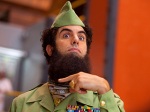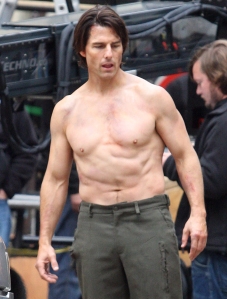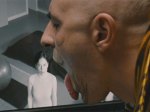Oh, hey.
I’ve been doing stuff since last we spoke, really I have. Productive stuff. Why, right now I’m finalizing blueprints on a sustainable urban childrens garden proj—ahhh who am I kidding? I’ve been watching movies about what it would really be like if The Incredible Hulk hung out with Iron Man. And let me tell you, I took MARVEL’S THE AVENGERS dead seriously, man. I did my prep work. Front to back, cover to cover, I read every single issue of every tributary comic series before even attempting to penetrate the complexities of the recent slate of Marvel films – all of them preceding, as four horsemen precede an apocalypse, THE AVENGERS, a film with absolutely no logical plot – so my months of preparatory comic book reading was for naught. Fuckin’ naught!
But my guess is, the record-smashing success of THE AVENGERS actually hinges on its irreverence to plot; that is to say, Joss Whedon’s film is a great illustration of the difference between plotting and storytelling. To have focused on the intricacies and inconsistencies in the so-called ‘Marvel Universe’ would have alienated a huge audience (basically, anyone who hasn’t wondered about what it would really be like if The Incredible Hulk hung out with Iron Man,) so writer/director Whedon skillfully threads his MacGuffin – a glowing “Tesseract,” dontchya know – through his film just enough to buoy his story. (Story, not plot, is the building unit, after all, of myth – and that’s what the best superhero tales are.) THE AVENGERS is, broadly, the tale of a big corporate team-building exercise. Marvel’s The Avengers meet, they joke, they fight, they fight and fight and bite, fight fight fight, bite bite bite – and nearly two-and-a-half hours fly by in Boys World before you’re being tantalized with the promise of more franchise entries to come. THE AVENGERS has moments of real humor and (where Mark Ruffalo’s glorious Bruce Banner is concerned) real pathos – and it looks outrageously hot. See it, if you haven’t, which you have. Unless, of course, you think comic books are silly, in which case, never see it. Because it will be the most indecipherable, boring thing you ever sat through. It’s that awesome.

THE CABIN IN THE WOODS’ Fran Kranz, shoo-in for a ‘High Times’ Stoner of the Year nod. Bet your bong on it.
Speakin’ of Whedon, here’s a guy whose career until recently has been marked by close-but-no-cigar Hollywood hard-luck. Joss Whedon took abortive stabs at tons of big movies; his TV series ‘Buffy the Vampire Slayer,’ ‘Firefly,’ and ‘Dollhouse’ were fan favorites with intricate backdrops, but they failed to reach a mainstream audience – probably for just that reason. So it’s ironic that in the same summer that Whedon finally breaks out as a blockbuster director, we get perhaps his most insular Whedonesque piece yet. Sadly, it’s one that sat on a shelf gathering dust for a year before MGM would even release it. One year late, Whedon and Drew Goddard’s THE CABIN IN THE WOODS is one of the best films of 2012 instead of 2011, a horror-comedy that must be seen, and must not be discussed around those who haven’t seen. Suffice to say, I hope Whedon’s AVENGERS grand slam brings an audience to this on Blu-ray, because CABIN really is an original – a clever, nihilistic, slasher-cinema-steeped delicacy that unlike the AVENGERS remains unpredictable up to its final seconds. I’ve seen it twice in theaters, I’ll see it again, and again and again, you can’t stop me. What’s clear from THE AVENGERS is that Whedon knows enough about genre filmmaking that he can create the genuine article at a level approaching perfection; what’s clear from THE CABIN IN THE WOODS is that he knows enough about it to pretty brilliantly deconstruct it. Either way, it’s Whedon’s summer so far.
If you’d asked me at the start of the season which comedy would come out on top, 21 JUMP STREET or THE DICTATOR, the answer would have been obvious. A remake of a shitty 80’s television show starring the inexplicably Oscar-nominated Jonah Hill and fucking Channing Tatum? Or a showcase for the new character from Sacha Baron Cohen? But how the Hollywood wheel of fortune spins! Not only could I not have predicted that 21 JUMP STREET would be so game and so consistent, thanks in large part to fucking Channing Tatum — but I never could have foreseen that THE DICTATOR would be such a whiff. Though his latest has laughs, Baron Cohen apparently feels that a barrage of ‘lesbians with hairy armpits’ humor is more immediate and topical than – you know – anything actually topical. And so THE DICTATOR is barely more than a collection of jabs at a rotation of moot targets. And I do mean ‘rotation.’ There’s not a gag here that isn’t called back four to nine times.
It is tricky to criticize films for the negative space they don’t fill, a slippery slope to call out a comedy for the jokes it doesn’t make, except, following BORAT and BRUNO, Baron Cohen has comedic carte blanche; perhaps more than any other working cinematic comic, he’s got a huge audience that has proven it will follow him into dangerous territory. So imagine if he’d used this film to actually say something a immediate as Chaplin did with his GREAT DICTATOR (a film this one conceptually apes.) Imagine if Baron Cohen had taken on the persona of a Middle Eastern tyrant and fired shots at radical Islam? Unfortunately, Baron Cohen is content to continue making his passe Anti-Semitic jokes, and continue to claim immunity as he does. Not only can Baron-Cohen the comic make these jokes because Baron Cohen is himself Jewish; but his Admiral General Aladeen can make these jokes because, as he states early on, he’s not an Arab. (What he is is never defined.) The filmmakers’ fear of entering into a real satirical conversation about Middle Eastern politics is perfectly illustrated in its finale: Aladeen gets married to Zoey (Anna Faris,) the “lesbian hobbit” he’s spent the film deriding. They say their ‘I do’s and Zoey crushes a glass under foot. Because, apparently, she’s Jewish. Aladeen immediately motions to his soldiers to have her executed. Cut to black, the end.
… Except, like every single comedy nowadays, that’s not the end, not when there’s a credit roll to fuck around with. And so we’re treated to several scenes over the end titles, in which we see that in fact, Zoey isn’t dead, she and Aladeen are blissfully married, and now expecting a baby… For a film that spends real estate a bogus redemptive path for its lead, THE DICTATOR leaves him at a completely contradictory point. He’s the non-Arab Middle Eastern nice guy bad guy tyrant who orders his Jewish wife dead, but not really… Haaa?
There are some who hold the first MEN IN BLACK in high regard; we’re talking GHOSTBUSTERS high regard. Those people, obviously, are not worth acknowledging with eye contact – especially since many of them talk about MEN IN BLACK II as if it’s a crime against cinema – a steep decline from the quality of #1. Frankly I can barely tell the two movies apart in retrospect, and MEN IN BLACK III faithfully upholds the series’ great ‘B/B-minus’ tradition. For a franchise that’s been dormant a decade, this new installment is fresher than it might have been, especially considering the litany of production horror stories surrounding it. You’ve got Josh Brolin doing an uncanny imitation of a young Tommy Lee Jones, you’ve got FLIGHT OF THE CONCHORDS’ Jemaine as an(other) insectoid villain – a slight variation on previous MIB heavies – and you’ve got Will Smith, being funny. But the action element of these films is never as enjoyable as the interplay of Jones and Smith, or Jones and Brolin for that matter. And there is a lot of action, though none of it really sticks. Who really remembers these films for their gadget-saturated alien shoot-out sequences? I assume there were several in part three, I can’t remember. I saw it a whole week ago.
I also spent the last week pondering MOONRISE KINGDOM, the newest Wes Anderson film – or more accurately, I’ve been trying to figure out why I didn’t like it, and whether it has more to do with me than with Wes. In the late ‘90’s, Wes was easily the most interesting, unique new voice in American film comedy, maybe in American film as a whole. As a high-schooler with more than a little Max Fischer in him (read: insufferably pretentious,) Wes’s second, RUSHMORE, was an instant personal watershed. THE ROYAL TENENBAUMS, then, was a gorgeous expansion on the ‘Andersonian’ style. Also, I named my dog Dignan after BOTTLE ROCKET. True story. Post-TENENBAUMS though, Anderson’s films have more or less offered diminishing returns with every variation on the theme. That being: bright-eyed youthful confidence (generally underscored by this or that Kinks song,) gives way to some small tragedy, and is finally resolved with a return to optimism, albeit with a new and delicate understanding of the world outside ‘The Wes Anderson Whimsy Bubble’ (TM.) MOONRISE KINGDOM basically fails to deviate.
I can’t exactly be upset with Wes Anderson for making a Wes Anderson movie. Most filmmakers in one way or another do just that – though Anderson, more than most, dares his audience not to draw the obvious parallels. I guess what I resent about MOONRISE is that Anderson forces the viewer to put it into the context of his other films, and so undermines what makes any one of them special in their own rite. In its way, it diminishes Anderson’s best work by stylistically & structurally drawing attention to what a blatant rehash it is. Here, we’ve got our innocents coming of age, our poignant sacrifice (in TENENBAUMS, it was Buckley the beagle, in THE LIFE AQUATIC it was Owen Wilson, in FANTASTIC MISTER FOX it was George Clooney’s tail, and in MOONRISE we’re back to killing dogs.) And we’ve got our predictably bittersweet optimistic resolve. So what if the protagonists here are children, instead of man-children, like Richie Tenenbaum or Steve Zissou or DARJEELING’s Whitman brothers? (Though with Edward Norton’s Scoutmaster Ward, Anderson does technically fill his MOONRISE man-child quotient.) Watching the man tick tropes off a list held little thrill for me. Maybe it’s me. After it was over, I sat down on my couch and put on RUSHMORE. You know, for a change. I mean, if all Wes Anderson is going to do is do the same thing over and over, why shouldn’t I?
Well, that’s all the catching up I have time for today. I’ll check back in once I’ve installed these solar panels and raised $10,000 for President Obama’s re-elec— ahhh, I’m going to see PROMETHEUS in IMAX 3D.































